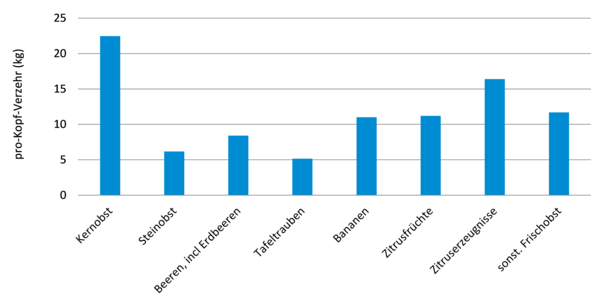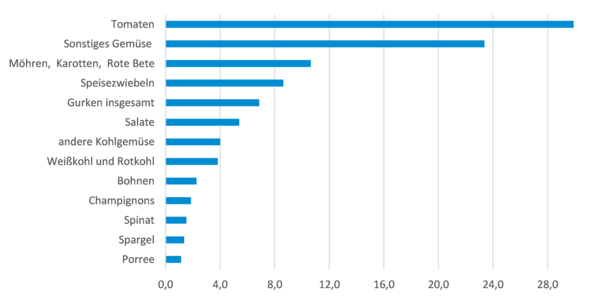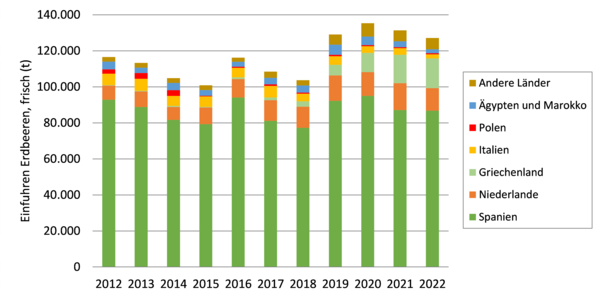FAQ
Trends in German fruit and vegetable cultivation
Hildegard Garming, Michael Welling, Kathrin Rieck | 02.08.2024
How have the production and consumption of fruit and vegetables developed in Germany in recent years? What are the most popular apple varieties and how large is the share of organically produced fruit and vegetables? We provide answers to questions like these below.
Fresh and healthy food are on on everyone’s table. The average consumption per person and day are around 600 grams. But what products exactly are actually consumed, what is at the top of the shopping list? How much of the different varieties are grown in Germany , and how much is imported? And looking at the large diversity: Can the different types of fruit and vegetables be grouped into categories to get a better overview? We provide answers to questions like these below.
Further, more in-depth information and graphic representations are provided by the horticulture fact sheets in Germany (only in German): „Vegetable Crops“, „Fruit Crops“, „Fruit Crops-Apples“ and „Fruit Crops-Strawberries“.
Around 97.5 kilograms of fruit every German consumed in 2022/23. This is 2.3 kilograms less than in the year before. More than half of fruit consumption is accounted for by species that cannot be grown in Germany: Citrus fruits and bananas already account for 42 % of fruit consumption. Pome fruits such as apples and pears are consumed the most, at 22.5 kilograms per capita. Annual banana consumption amounts to 11 kilograms, as in the year before. The other types of fruit are significantly less important in terms of volume, as they are mainly in seasonal demand; stone fruit, strawberries, bush berries, table grapes and other fresh fruit (mainly exotic tropical fruits) together account for around 34 kilograms per year.
Vegetables are in vogue: According to the new horticulture fact sheet „Vegetable Crops“, vegetable consumption in Germany has increased by 24 % over the past 20 years. In 2022/23, per capita consumption was 103 kilograms. This represents a decline of 8 kilograms compared to the year 2021/22. Carrots and beetroots (10.6 kg per capita consumption), onions (8,6 kg) and fresh tomatoes (7.4 kg) are particularly in demand. In terms of local vegetables, i.e. those grown in Germany, it was mainly carrots, onions, cabbage, leeks and asparagus that ended up in Germany's pots.
In the case of local fruit, the focus is on tree fruit such as apples, pears, plums, prune plums and sweet and sour cherries. Due to both the climate and tradition in many regions, apples cover by far the largest share of fruit tree acreage in Germany with 48 % cultivated area. Also, strawberry fields can be found everywhere in Germany - they represent 20 % of the cultivated fruit area.
As the yields are different for the different fruit types, the harvest volume is distributed somewhat differently: 86 % is accounted for by tree fruit and 11 % by strawberries, while bush berries account for only 3 % of the total fruit harvest.
Among the vegetables produced in Germany, carrots, onions and cabbage have played the leading roles in recent years. Particularly, carrots and onions are still facing an upward trend. While the area under pumpkins has increased in recent years, the area under gherkins and cabbages such as cauliflower and Chinese cabbage has decreased. Broccoli, on the other hand, is being grown more. The amount of leaf and stem vegetables grown has remained more or less the same. The area under rocket and romaine lettuce has increased.
Most of the fruit and vegetables sold and consumed in Germany come from abroad. The most important import countries include Spain and the Netherlands, closely followed by Italy. But non-EU countries such as Costa Rica, Mexico, Ecuador and South Africa are also important import countries for Germany.
Concerning vegetables, tomatoes, cucumbers and peppers are among the most important imported kinds. Vegetable imports increased significantly between 2004 and 2020, but have fallen slightly since then.
Fruit imports have remained relatively constant over the years. Citrus fruits and bananas dominate in terms of volume. Mangoes and guavas have decreased again in import values since 2021. While the import volumes of kiwis have stagnated, more pineapples have been imported again. Exciting: strong momentum can be observed in avocado imports, which have quadrupled since 2011 and continued to increase in 2021 and 2022!
For apples, a distinction must be made between dessert apples (mainly for direct consumption) and cider apples (for further processing, e.g. into juice or mush). In 2021, around 1.1 million tons of dessert apples were consumed in Germany, while local production amounted to around 760,000 tons. Germany can therefore supply itself with dessert apples for the most part (see question 5). Imports come mostly from EU countries (>80%), mainly Italy, followed by the Netherlands, France and Poland. Apples can be stored for a very long time and can be offered in good quality all year round. In spring and summer, additional apple imports come from southern hemisphere countries such as Chile and New Zealand, where the harvest season is then. Imports of cider apples have fluctuated greatly over the past 10 years; the most important import country for some years has been Poland, followed by Italy, the Netherlands and the Czech Republic.
Germany imports and exports fruit and vegetables. However, imports are much higher, which is why Germany is referred to as a "net importer". The proportion of fruit and vegetables produced in Germany that are also consumed in Germany is indicated by the degree of self-sufficiency.
In the case of fruit, this averaged 15% from 2010 to 2022. This means that 85% of the fruit consumed in Germany comes from imports. This is related to the high consumption of citrus fruits and bananas (42 % of total fruit consumption), which do not grow in our country.
An interesting single aspect are dessert apples. For them, the self-sufficiency rate averaged 60% from 2011 to 2021 (fluctuating between 40% and 66%, depending on the harvested quantities per year).
The degree of self-sufficiency for vegetables in Germany averaged 36% from 2004 to 2023, significantly higher than that for fruit. The differences between the vegetable types are large. The highest degree of self-sufficiency is for cabbage, asparagus, carrots, onions and leeks. The ranking of vegetables produced and consumed in Germany is headed by cabbage, asparagus, carrots and leeks. They are grown outdoors, usually have a good storage life with the exception of asparagus, and are marketed in both fresh and processed form.
Looking at exports, for vegetables it is mainly onions, cabbage, carrots, lettuces and cucumbers produced in Germany that leave the country. The destination countries are very different: carrots are mostly delivered to the Netherlands, for onions Poland and the Czech Republic are the most important customers, for white and red cabbage it is Sweden. Exports to non-EU countries take place only in very minor quantities. About 1.3 million tons of locally produced vegetables were exported in 2021 (compared to 7.7 million tons of imports).
Of locally produced fruit, about 3,9 million tons were exported in 2021.
Organic cultivation has increased sharply in Germany in recent years and currently accounts for 15 % of the total cultivated area and 11.5 % of total production in terms of vegetable production. The area of organic vegetable cultivation increased steadily between 2014 and 2021. In 2022, there was a decline in the organic vegetable area for the first time during this period. In 2023, however, the area under organic vegetables increased again.
In apple production in particular, just under a quarter of the land in Germany is farmed organically. There are major differences between the German states. In Mecklenburg-Western Pomerania, for example, almost 70% of the apple-growing area is managed organically; there, the cultivation of cider apples for juice production plays a particularly important role.
The Elstar variety and the group of Jonagold varieties together account for a good third of the apple harvest and are thus among the most important varieties in Germany. Braeburn, Gala and Boskoop also play an important role in domestic fruit growing (see figure).
Overall, a very large variety of apples is cultivated; the cultivation statistics show 83 different varieties. According to the horticulture fact sheet „Fruit Crops-Apples“, so-called club varieties such as "Pink Lady," "Kanzi" or "Jazz" are also in vogue. These are licensed apple varieties marketed under a specific brand. Their harvest volume has increased sharply in recent years and accounted for 4.8 % of the total apple harvest in 2022. This represents an increase of 53% compared to the harvest in 2021.
The so called „Altes Land“ („Land"), a region in northern Germany which stretches across Lower Saxony and Hamburg, and the Lake Constance region are widely known as "apple regions". This can be seen well in Figure 8 (horticulture fact sheet „Fruit Crops-Apples). With regard to the total area under apple cultivation (33,106 ha), the German states show great differences. Clearly in the lead are Baden-Württemberg with about 11,610 ha and Lower Saxony with 8,350 ha.
There are about 5,000 fruit farms growing apples in Germany. Of these, more than half are small farms of less than 5 ha. Nevertheless, a few larger farms of at least 20 ha account for the majority of the cultivated apple acreage.
Germany is a “net importer” of fresh strawberries, which means that imports are much higher than exports. Imports fluctuate between years. In 2023, 114,000 tons of fresh strawberries were imported. Two-thirds of imported fresh strawberries come from Spain. Other important European import countries of fresh strawberries are the Netherlands, Greece, and Italy. The import amount of strawberries from Greece has increased significantly in the last four years. Non-European imports, e.g. from Egypt and Morocco, play a minor role with only 3 %.
In 2023, strawberries were cultivated on 14,010 hectares, of which 2,042 hectares (around 15 %) were cultivated under high, accessible protective covers, usually foil tunnels (Destatis, 2024). Strawberry cultivation in the open field has steadily declined since the last years, while cultivation under protective covers has steadily increased. In 2023, one third of all strawberries harvested in Germany came from protected cultivation.
Growing strawberries in a foil tunnel increases area productivity and improves harvest quality, through better protection against weather risks and fewer plant protection problems. Another major factor is the significantly higher labor productivity in protected cultivation, which has steadily gained in importance due to the high labor time required for harvesting and the increase in wages.
There are several approaches to classifying crops into fruits and vegetables. Fruits are mainly sweet-tasting fruits with seeds of perennial, often woody plants. In the vegetable group are usually sorted rather savory, from root, tubers or leaves originating plant parts of annual, herbaceous crops. However, there are exceptions for both sides.
Local fruits can be roughly divided into three categories: Pome fruit, stone fruit and berries.
Apples, pears or quinces, which belong to the rosaceous plants (Rosaceae), are called pome fruits. This group of fruit trees produces fruits, which have a core with five chambers. Pome fruit is often characterized by good storage quality.
The term stone fruit includes fruits such as peaches, plums, yellow plums or cherries - also rosaceous, but which form one larger seed encased in pulp.
The category of berries includes berry bushes or plants that bear perennial rather small, roundish and juicy fruits such as currants, blueberries, raspberries or even grapes. Strawberries are actually considered to be a so called aggregate accessory fruit due to their botanical classification, but are usually counted as a berry due to their appearance and taste.
Local vegetables can be broadly classified into six categories: Fruiting vegetables, leafy and stem vegetables, root and tuber vegetables, cabbage vegetables, legumes, and onion vegetables.
Fruiting vegetables include annual plants that form edible fruits above ground, such as cucumbers, squash, zucchini, tomatoes, and peppers.
Leaf and stem vegetables include asparagus, spinach, chard, lettuce and celery. As the name suggests, it is not the fruits that are consumed here, but the leaves and stems of the plants. The leaf stalks are usually fleshy thickened.
Root and tuber vegetables include beet, carrots, parsnips, celeriac and radishes. The difference between root vegetables (such as carrots) and tuber vegetables (such as celeriac) is that in root vegetables, the edible part comes from the root. In tuber vegetables, a rhizome or "earth shoot" is formed, and roots then form on the underside of the rhizome.
Cabbage is a collective term for cabbage species from the cruciferous plant family (Brassicaceae) and includes, for example, red cabbage, white cabbage, cauliflower, broccoli, Brussels sprouts, or kale.
In the case of legumes such as peas and beans, either the seeds are harvested in fresh or dried form, as in the case of peas or broad beans, or the whole pod, is eaten with the then still tender immature seeds, e.g. green beans or sugar snap peas. The special feature of this plant family is its ability to bind nitrogen from the air with the help of nodule bacteria that settle in its roots and make it available to the plant. Legumes are comparatively rich in protein and therefore play an important role in vegetarian/vegan cuisine.
Plants belonging to the onion vegetable group form onion-shaped storage organs. In addition to vegetable onions and shallots, they also include garlic. Leeks are also classified here, although they do not form an actual onion.
Since the groupings follow more practical aspects and do not reflect a botanical-systematic classification, other categorizations are also possible. For example, a distinction is also made between coarse and fine vegetables, whereby the nature of the cell walls (stable or tender) plays a role. Coarse vegetables include white cabbage, red cabbage, beet, celery, onions and broad beans. Typical fine vegetables are vegetable peas, cauliflower, tomatoes, spinach or asparagus.














